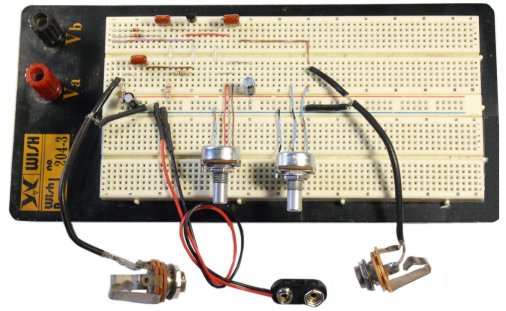
Welcome To The Deep Cave!
|
|
 |
Welcome To The Deep Cave! |
| How-Tos! | ||||
| These articles cover some general electronics DIY methods and techniques and specific practical information on constructing stompboxes. | ||||
|
|
Beginner Dos and Dont's - For those who have never built a pedal, a lot of notes on mistakes I have made and seen other people make, how to avoid them, and how to pick a first project. | |||
|
|
The FAQ For Fuzz Face Fanatics - Some notes on what transistors are suitable for Germanium Fuzz Face clones and how to select them, and the "Bear Bones" method of testing gain. | |||
 |
Tools For Building Electronic Projects - A guide to shopping for what you need to get started, and suggestions for later additions. Also some notes on organizing your bench and shop. | |||
|
|
Drawing Schematics - MS Paint, which is included in all versions of Windows, can be used to draw schematics and board layouts. While this article refers to Windows 95 and 98, the general idea is still valid. In time, I will update it for later versions. | |||
|
|
Making PC Boards By Direct Etching - This is essentially the instruction manual for the Press N' Peel PC board-making kit in the Stock List. It covers cutting cutting PC board stock to size, using Press N' Peel film and etching techniques. | |||
|
|
Making PC Boards By The Positive Photo Process - This is the instruction manual for the Photo PC board-making kit. It covers cutting photo-sensitized PC board stock to size, creating transparencies, developing and etching techniques. | |||
|
|
Designing A Shell And Creating Paper Templates - You have a circuit that you like enough to put in an enclosure, and you want to be sure that everything will fit and be in its proper place. This is a look at some of the design factors, working with a draw program and some methods and tips for designing new drilling templates. | |||
|
|
Tooling A 5-Knob "Shell" - Here is a step-by-step guide to crafting a housing for a stompbox. It is applicable to anything that you would want to build in a "BB"-size enclosure, with up to five potentiometers. Also included is a repeatable method for implementing on-board bypass switching. | |||
|
|
Tooling A 3-Knob "Shell" - This version is designed around a "B"-size enclosure with up to three, 9mm, on-board potentiometers. | |||
|
|
Modding An Expression Pedal To Use A Standard Pot - How to create a pedal controller with a pot that isn't 100K or 200K. | |||
|
Breadboarding - Methods, Ideas and Layouts |
||||
 |
Using A Solderless Breadboard - Teaches the basics of using this tool for prototyping. Contains a lot of essential information for beginning builders, and it's the introduction to the subsequent How-Tos on setting up effect circuits. | |||
| Breadboard A Rangemaster - Set up this classic and tweak performance. Layouts are shown for both standard PNP and NPN versions, and notes are included on two-transistor Darlington variants. A beginner-friendly kit is available. | ||||
|
|
Breadboard The Ursa Minor - A Beginner's Boost - From where the intro article leaves off, walks through the setup of a one-stage boost similar to the Electra Distortion, tweaking performance, and a few mods. A kit is available in the Stock List. | |||
| Breadboarding A Silicon Fuzz Face - From where the intro article leaves off, walks through the process of going from a schematic to a working circuit and tweaking performance. A kit is available in the Stock List. | ||||
| Breadboarding A Vintage IC Distortion - From where the intro article leaves off, learn to set up a preamp, driver stage, diode clipping and a tone stack. A kit is available in the Stock List. | ||||
| Breadboard A Germanium Darlington Fuzz Face - Use low-gain parts, and you don't have to break the bank to create a boutique-quality FF! A beginner-friendly kit will be available soon. | ||||
| Breadboard A Bare-Ass Boost - Learn how to set up a two-stage JFET boost with tone stack. A beginner-friendly kit will be available. | ||||
|
|
Build An IdeaBox or An IdeaBoard - These are "deluxe breadboards"--complete prototyping environments, specifically geared to building stompboxes, that can be built mostly from standard hardware. They are relatively inexpensive, they cut development time a lot, and the IdeaBox makes it practical to try out a new design in a gigging environment. | |||
|
|
|
Copyright © 2013 Small Bear Electronics LLC All Rights Reserved. Small Bear Electronics has no agents, distributors or representatives. Any other company that has "smallbearelec" in any part of its name or domain name has no connection with us. |